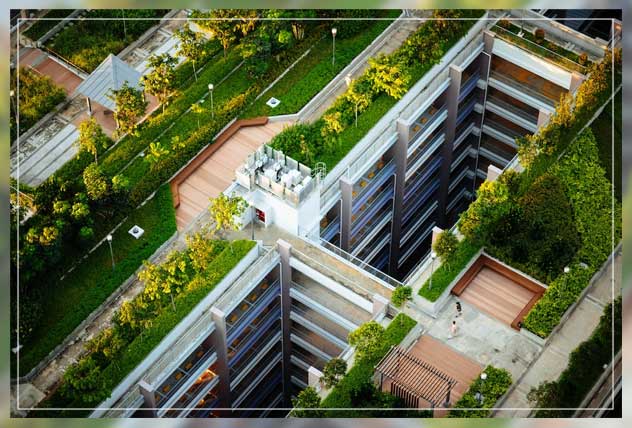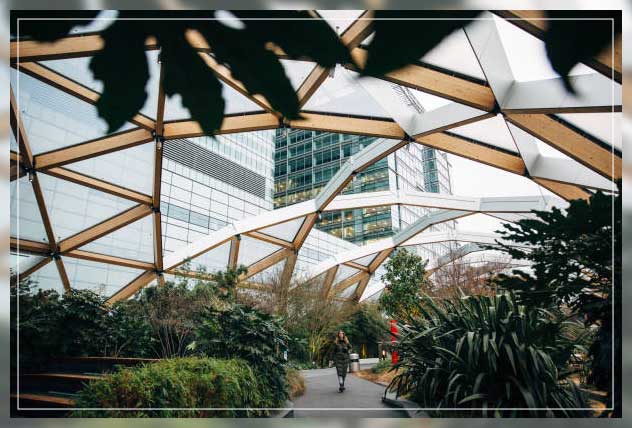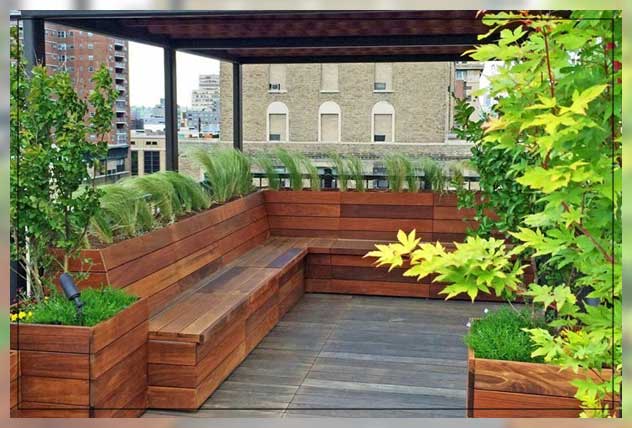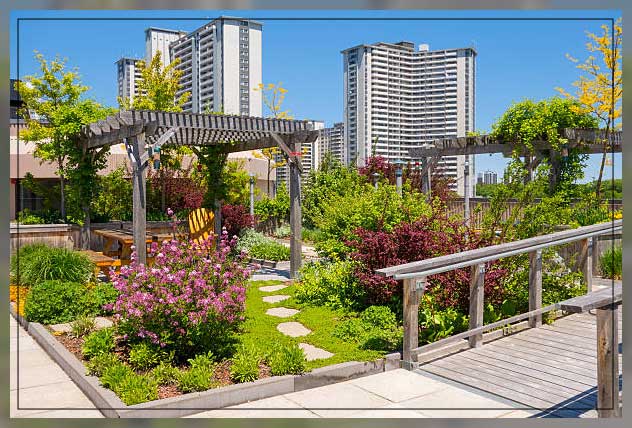City dwellers wanting to add a touch of nature to their apartments, resort to building a rooftop garden.
Though, this is not a new concept.
In fact, green roofs that is covering the roof with soil and plants have been a common idea for years.
In order to make your space more green, rooftop gardening is gaining popularity in not only residential but also on commercial sites.
Or if you are simply running out of enough room for your plants, there is always the rooftop to utilize.
This article discusses how you can set up your rooftop garden and what are the pros of doing it.
Let’s know more below!

What is a Rooftop Garden, Options and Advantages
A rooftop garden generally refers to container plants.
However, making a green roof with the soil covering the roof and plants sowing inside the soil is a good option too.
It comes with its set of cons as well.
It is harder for homeowners to maintain and build it on their own.
After all, the weight of a green roof can easily reach around 100 lbs per square foot.
The installation and structural analysis of your rooftop is important before you begin this and maybe you will need a professional company to do it for you.
The safest option then is to go back to container plants and the raised beds.
You can simply put a few plants in terracotta pots or you can work around constructing garden beds that have an automatic water system.
You can add any kind of plants, edible vegetables, to flowers and ornamental shrubs.
While selecting the containers, ensure that they are light enough.
This makes them the ideal choice for rooftops as the containers will not weigh a lot, and are also affordable, easy to carry and flexible.

Are you still hesitant to decorate your rooftop?
Makes sense!
If you have other spaces in your house then maybe rooftop gardening isn’t for you.
Though, if you lack space then it can be a spacious area to grow your plants in privacy.
It is also the most underused space which gets plenty of sun exposure. Use that sun exposure wisely on your plants.
Growing plants on your rooftop are extremely environmentally friendly plus it makes your empty unused space beautiful and refreshing.
The best part is that you can grow your plants in peace.
There will be no pets or nonflying pests and animals coming in that area.
Convinced? Let’s begin to make it.

Types of Plants in Rooftop Garden
The weather conditions on each rooftop can be different.
While some may get plenty of sun, others will be covered in shade due to surrounding buildings.
There may also be high humidity or winds reaching the rooftop.
Therefore, consider these factors before you choose what plants you can deploy on the rooftop.
Given the uncertain conditions, some plants may still survive there.
These include:
Shade Tolerant Plants
If there is not enough sun reaching the roofs and surrounding trees and buildings simply shade, these plants can still thrive.
Shade tolerant plants or partial sun plants such as hostas and lettuces can be your pick.
On the contrary…
Sun-loving plants
When your roof gets full sun which is around 6 hours per day then sun-loving plants are your obvious answer.
Let your plants soak in the sun to grow well.
Though, if they get a lot of sunlight then go for full sun plants such as strawberries and tomato plants, or flowers like marigolds.
A full sun may also burn plants hence, choose those that can tolerate it.
Drought-Tolerant Plants
Low maintenance plants are the best for any home gardener.
If your roof receives plenty of sun and wind then it will also need regular watering.
In case, you do not have an irrigation system such as drip irrigation or rain barrel cistern, you will have to fill and deliver water.
Thus, drought-tolerant plants like butterfly weeds, sage and evergreen shrubs are easily manageable.
Wind-Tolerant Plants
At times rooftops have higher wind conditions because they are no buildings or trees blocking it.
In that case, consider planting ground covers and low-to-the-ground shrubs.
These include hydrangea, ornamental grass and honeysuckle bushes.
Therefore, check the conditions on your roof and choose which plants will go sustain well there.

Considerations
Checking Building Permissions and Codes
Urban dwellers need to first check with their landlord or the building code of the apartments/condos.
Some people may not allow using roofs because of fire regulations, accessibility and building height restrictions.
Therefore, before dreaming of your rooftop garden, ensure that it is even allowed.
Access to the Place
How are you going to get in the plants and set up the water supply?
Also, keep in mind how you are going to bring your material in and out.
Can you use an elevator or multiple exits, in case you have a shared rooftop?
Storage Space
You will need several gardening tools and materials such as fertilizer, buckets and compost.
Do you have enough space to store it all?
You can make a separate shelf to put all of this gardening material in one place.
Weight Limits and Structural Integrity
Look for containers that are lightweight and have proper drainage so that the plants don’t stay soggy.
Use fiberglass, plastic, wooden or foam planting containers rather than stone or concrete.
Not only that, but also use lightweight potting soil instead of garden soil.
For drainage, opt for styrofoam peanuts rather than heavy rocks and pottery shards.
Cost
You cannot miss out on the expenses when you are thinking of investing in a garden.
You can begin with a few plants as more expenses come with hardscaping.
This will include making raised beds, laying tiles, and adding lighting as well as structural work for support.
Consider all of these expenses beforehand.
Electrical Wiring
It is not necessary to have electrical wiring, however, it may be important to enjoy your garden at nighttime.
Thus, consider deploying the wiring when you are planning the entire garden.
Alongside caring for other things such as soil, sun, wind and water.

Care
Choosing Plants
Firstly, select the plants that can sustain the conditions of your rooftop.
Is there enough sun, so the plants should be sun-loving, if not, they should be shade tolerant?
Wind
Blocking wind can be crucial such as a high wall or fencing.
The windbreaks will prevent your plants present on the roofs from being blown over due to the fast winds.
A trellis can also work to anchor your plants in place preventing the strong gusts from reaching them.
Sun and Heat Exposure
Usually, roofs get a lot of sunlight.
While sun-loving plants may tolerate it and grow well, other plants may dry out due to direct heat and sun exposure.
The heat reflected from the roof surface, metal exhaust and utility structures and buildings all reach your plants.
Thus, you need to give the plants some sort of shade.
Preparing Soil and Plantation
There is no soil on the rooftops, so you will have to purchase one to use in your plants.
Plants can sustain well in well-draining soil such as potting soil that has rich organic matter.
Once you have the soil ready, dig holes in the container and plant the chosen plants.
The next step is to water the plants thoroughly.
Water Supply
Check if you can install drip irrigation which connects to a root level water spigot or rain barrel that catches rainwater, as these are the best options.
If you can bring a water hose to the rooftop that will suffice too.
However, watering cans and containers are heavy and require space plus lots of water.
If you can handle carrying a watering can each day, then you can continue with that.
Privacy
Improve privacy on the roof by adding an umbrella table, vines on trellis or hedges of evergreen for coverage.

Cons of Rooftop Garden
While there are several advantages and pros of making a rooftop garden, it also comes with its set of cons.
These are basically the considerations and restrictions that may prevent you from installing plants on your roof.
- Inclement weather conditions: The weather conditions on rooftops are different from that on the ground. These can be adverse conditions such as high winds, hot temperatures, extreme cold or wet conditions. Hence, you should get hardy plants considering the weather conditions on your roof.
- Weight limitations: Unlike the grounds, roofs can only handle a certain amount of weight. Thus, considerations should be taken in selecting the containers, soil or installing a rain barrel.
- Watering System Difficulties: Making a sustainable watering system is harder on roofs. Setting up drip irrigation or cistern will require structural work. On the other hand, the plants need more water on the roofs due to the harsh weather conditions on the ground.
- Can Only be in Containers or Raised Graden Beds: There is a limitation on the variety of the plants because they can only be in raised garden beds or containers. This is also more costly than planting in the ground.
Finally,
If you are planning to make a rooftop garden, this is your full guide.
Keep in mind these considerations before you plan to set it up and return here to know how to care for upur plants on the rooftop garden once it is established.






Leave a Reply